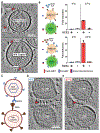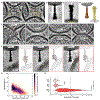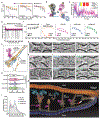Structure and inhibition of SARS-CoV-2 spike refolding in membranes
- PMID: 39146425
- PMCID: PMC11449073
- DOI: 10.1126/science.adn5658
Structure and inhibition of SARS-CoV-2 spike refolding in membranes
Abstract
The severe acute respiratory syndrome coronavirus 2 (SARS-CoV-2) spike protein binds the receptor angiotensin converting enzyme 2 (ACE2) and drives virus-host membrane fusion through refolding of its S2 domain. Whereas the S1 domain contains high sequence variability, the S2 domain is conserved and is a promising pan-betacoronavirus vaccine target. We applied cryo-electron tomography to capture intermediates of S2 refolding and understand inhibition by antibodies to the S2 stem-helix. Subtomogram averaging revealed ACE2 dimers cross-linking spikes before transitioning into S2 intermediates, which were captured at various stages of refolding. Pan-betacoronavirus neutralizing antibodies targeting the S2 stem-helix bound to and inhibited refolding of spike prehairpin intermediates. Combined with molecular dynamics simulations, these structures elucidate the process of SARS-CoV-2 entry and reveal how pan-betacoronavirus S2-targeting antibodies neutralize infectivity by arresting prehairpin intermediates.
Conflict of interest statement
Figures




References
Publication types
MeSH terms
Substances
Grants and funding
LinkOut - more resources
Full Text Sources
Miscellaneous

